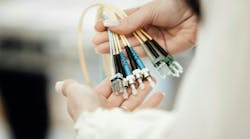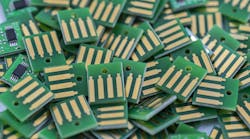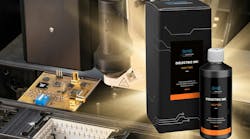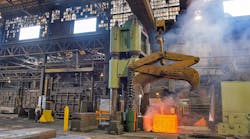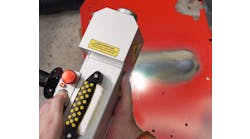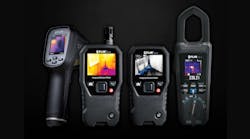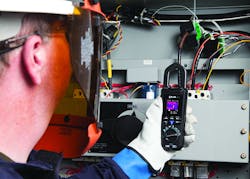Jeff Stricker, a self-employed appliance repair technician in the Des Moines area, finds that when it comes to convincing clients they have an electrical problem, seeing is believing.
If their fuse box has a bad breaker, the best way to prove it is to pull the panel off and show them the charred wire.
“I almost have to take that step, because if I don’t, I get contradicted so often,” Stricker says. “I have to prove things to customers so we’re on the same page.”
A recent tool the technician has acquired, the FLIR CM174 Imaging 600A AC/DC Clamp Meter, makes that task easier than ever, he says.
on the clamp meter, eliminating the need for a thermographer in many cases.
Photo:FLIR
This device combines the expected spectrum of electrical diagnostic functions—voltage, current, frequency, resistance, etc.—with a FLIR Lepton microbolometer that uses long-wave infrared sensing and a laser pointer to guide the user to trouble spots, or, on the other end of the project, to verify an issue has been resolved.
It’s part of FLIR System’s new Infrared Guided Measurement (IGM) line that comprises the clamp meter, two moisture meters, and spot detector. (An IGM multimeter is expected in Q4.) As with the Cat S60 smartphone, this line of devices fits into FLIR’s overall goal of making the infrared spectrum universally visible to the naked eye, sort of like what Nintendo has done with Pokémon. But instead of wasting time running in circles chasing lightning spewing Pikachu, these IGM-embedded devices will augment your ability to hone in on previously invisible problem areas ranging from hidden hot spots to festering moisture pockets.
House Call
The CM174 usually rides shotgun in Stricker’s work truck as he makes his stops, because he’s doesn’t want his precious new $500 gadget rustling around in his tool bag.
He also is having trouble letting go of his old clamp meter, a well-worn tool that’s been “dying out,” that’s shown recent spurts of life. Saying goodbye to a trusty friend isn’t easy, even on without futuristic features.
Stricker will still go first to the old clamp meter, as he did recently at a house call where an oven-range combo wasn’t working. The oven’s back panel looked fine, so he went to the basement to reset the 240V breaker, which had tripped. Once that was done, the oven started to work again, and he slowly increased the amperage by systematically turning on each burner and then the oven, monitoring the current strength until it pulled 38 amps.
Now it was time for the CM174 hybrid clamp meter to demonstrate its new tricks. Stricker grabbed it from the truck and went to the basement breaker box.
With the oven on full blast upstairs, he turned on the FLIR meter.
“I wasn’t even prepared for what happened,” he recalls. “I stepped up the breaker and I saw this distinctive red rectangle [in the display]. I wanted to pinpoint it, so I could see where the problem was. I turned on the laser light and could actually see what bank of the double breaker was bad. There are two lines going in and I could pinpoint which one it was.”
The resident could also see for himself that indeed he should start dialing an electrician to replace the breaker. And Stricker didn’t need to worry about removing any panels or arguing with customers.
“He was impressed; I was impressed,” Stricker says. “I love it. It just puts one tool in my hand that I can use for multiple things. I really gotta’ put it in my tool bag.”
problem to save on energy.
Image: FLIR
Fix It Faster
“The paradigm in the past was the thermographic specialist would go through the plant and find problems, and then the electrician, who has the diagnostics tools, would take a look at the thermal image and identify where the problem was,” says Tom Scanlon, VP of Test Equipment Business Development at FLIR.
In that paradigm, the electrician might then take measurements using the multimeter, replace the fuse, and then go to the next trouble spot, he continues.
That’s one relatively minor problem, and two different people and two pieces of equipment to tackle it. And that’s best case scenario.
“Very often, the electrician might go through the fix but might not have solved the problem,” Scanlon says. “In order to validate the corrective action was taken, you need to have thermographer come back.”
If the technician has thermal built into the diagnostic device, Scanlon argues, after fixing the fuse and powering up the cabinet, a quick thermal scan will indicate if the temperature change between phases is within a normal threshold, thus indicating the problem is gone.
“This tool eliminates the need for a lot of substantial data collection,” Scanlon says. “Electrician can see what they have to fix in the field, in real time.”
The micro-sized Lepton microbolometer provides an 80 x 60 thermal image resolution display to direct where the temperature is abnormal, and where exactly your diagnostic efforts should be focused.
This IGM method should not only change how electricians approach a job, but nearly every aspect of the factory floor could stand to benefit as the thermal revolution heats up.
In July Scanlon was in Chicago talking to restoration contractors about the Lepton-embedded moisture meters, the MR160 and premium MR176, which have two basic functions: to seek out wet spots and verify if they are actual moisture or cool air.
“There’s a good 5 or 6°F difference between wet and dry drywall,” Scanlon says. “Moisture and buildings don’t mix well, with mold being the most significant problem.”
Instead of tearing up an entire carpet, or gridding a wall to find where that burst pipe did damage, an inspector just needs to point-and-shoot.
“We are answering the question of ‘Where do we need to make the measurement,’” Scanlon surmises of the IGM line. “It will take some time before the world understands that this is a value that makes a difference.”
That understanding seems to be growing as the thermal revolution heat up.
Becoming a Common Sense
This is evident every day by John Keane, global director for the Infrared Training Center, a FLIR-funded, brand-agnostic organization that offers 4-day classes across the country on the theoretical understanding and hands-on application of thermal imaging, including how to get accurate measurements and how to interpret them.
“Taking a temperature measurement requires some knowledge of what you’re doing,” Keane says. “Some people think it’s point-and-shoot, but it’s actually little more complex than that.”
OK, so maybe until people know what they’re doing, we’ll refrain from calling it a revolution, and use “growing movement.”
But five years ago, the mobile school averaged about 1,500 students per year. Now more than 3,000 attend annually, and classes are offered 200 times a year around the U.S. and Canada. A schedule can be found at here.
Keane recalls that when he started selling thermal cameras 17 years ago, they cost $60,000. Now you can get them embedded in your test equipment or mobile phone for under $600.
This proliferation is leading not only to early adoption, but total embrace in some areas. A snowmobiling buddy of Keane’s, Rob Camman, tried out the FLIR E8 Industrial Thermal Camera in the Plumbing/ HVAC business he owns.
Camman’s business often performs energy audits for manufacturing facilities, which get breaks from the utilities for reducing their load. He would notice egregious energy efficiency mistakes such as finding 600 feet of 6-in. steam piping running through a refrigerated processing plant.
Showing the plants the error of their ways with a thermal display took mere seconds, and made them instant acolytes of thermal imaging.
“We ended up putting together tool kits and selling them to manufacturing plants,” Camman says. “These plants started off with one or two, then the manufacturers’ different locations ended up fighting over them, so they would buy another one, and then another one.”
Because of cases like this, FLIR has every right to be confident detecting the infrared spectrum will become the “the world’s sixth sense” in the 21st century, one that will lead to more sustainable, efficient operations simply by showing people what’s already there.
“We believe ultimately the consumer will come to appreciate it,” Scanlon says. “Thermal imaging will become an expectation and a must-have feature in the future. No one years ago considered a map or camera necessary on a mobile phone. Today no one would think of having one that didn’t include these as standard.”


